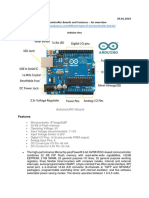Classification Test For
Uploaded by
Mediatrix SaraosClassification Test For
Uploaded by
Mediatrix SaraosCLASSIFICATION TEST FOR Carmina Pea, Martin Lorenzo Pineda, Jan Marc Punongbayan, Maria Mediatrix Saraos, Nympha
Elisa Sia, Bito Solima Jr. Group 8 2C Medical Technology Organic Chemistry Laboratory ABSTRACT Different classification tests were performed in this experiment in order to . Carboxylic acids are
EXPERIMENTAL
A.SAMPLES USED/ MATERIALS
acetyl chloride, acetic anhydride, ethyl acetate, acetamide, benzamide, 2% ethanolic AgNO3, saturated NaHCO3, 25% NaOH soln., 10% NaOH soln., 20%NaOH soln., glacial acetic acid, 95% ethanol, conc. H2SO4, aniline, 1M HCl soln., alcoholic NH2OHHCl, 5%FeCl3 soln., 1M KOH, test tubes, beaker, marbles/parafilm, litmus paper
B.PROCEDURE 1. Hydrolysis of Acid Derivatives For Acyl halides and Acid Anhydride, 1 ml of water was placed in two separate test tubes. 10 drops of sample, which is acetyl chloride and acetic anhydride, were added into separate test tubes in a drop wise manner. Warming effect was noted. The resulting mixture was divided into two portions. To the 1st, 1 ml of 2% AgNO3 was added and formation of precipitate was observed. While to the 2nd portion, 1 ml of saturated NaHCO3 was added. Evolution of gas was noted.
For Esters, 2 ml of 25% NaOH solution was added to a 1 ml sample which is the ethyl acetate. The mouth of the test tube was covered with a marble or masking tape then it was heated in a boiling water bath for 5 minutes. After that, the mixture was neutralized with 10% HCl solution. With a wafting motion, the odor of the solution was noted. For Amides, 1 ml of benzamide was treated with 5 ml 10% NaOH solution then it was heated until boiling. While heating, the reaction of test evolution was done by holding a piece of moist red litmus paper over the test tube. 2. Alcoholysis: Schotten-Baumann Reaction 10 drops of acetic acid, 1 ml ethanol and 5 drops of conc. H2SO4 was over a water bath for 2 minutes. The odor of the ester formed was noted. Another test tube with 0.5 ml of ethanol, 1 ml of water, and 0.2 ml of acyl halide sample (acetyl chloride) or acid anhydride sample (acetic acid) was combined with 20% NaOH solution. The tubes were covered with a cork or parafilm and the mixture was shaken for several minutes. The
odor of the ester formed and the formation of two layers were noted. C. Aminolysis: Anilide Formation Few drops of acetyl chloride or acetic anhydride sample were added to 0.5 ml aniline. The mixture was transferred to a new test tube containing 5 ml of water. The formation of precipitate was noted. D. Hydroxamic Acid Test A preliminary test was done first before the test itself. In here, 2 drops of the sample which is ethyl acetate or acetamide was mixed with 1 ml of 95% ethanol and 1 M HCl. The color produced was noted when 1 drop of 5% FeCl3 solution was added to the mixture. When the preliminary test produced a yellow color solution, the test proper was done. Two drops of sample was added to 2 ml of alcoholic NH2OHHCl, and 1 M KOH. The mixture was heated in a boiling water bath for 2 minutes. It was cooled and 1 ml of 5% FeCl3 solution was added. A deep burgundy color was observed, indicated a positive result.
You might also like
- Shin-Nippon SLM-4000-5000 - Service Manual PDFNo ratings yetShin-Nippon SLM-4000-5000 - Service Manual PDF46 pages
- Formal Report, Carboxylic Acid and Derivatives88% (8)Formal Report, Carboxylic Acid and Derivatives4 pages
- Classification Tests For Carboxylic Acid and DerivativesNo ratings yetClassification Tests For Carboxylic Acid and Derivatives4 pages
- Formal Report Carboxylic Acid and DerivativesNo ratings yetFormal Report Carboxylic Acid and Derivatives4 pages
- Classification Tests For Carboxylic Acid and DerivativesNo ratings yetClassification Tests For Carboxylic Acid and Derivatives4 pages
- Classification Tests For Carboxlyic Acids and Their Derivatives Experiment 10 Formal Report100% (1)Classification Tests For Carboxlyic Acids and Their Derivatives Experiment 10 Formal Report4 pages
- Tests For Categorizing Carboxylic Acids and Their DerivativesNo ratings yetTests For Categorizing Carboxylic Acids and Their Derivatives7 pages
- Tests For Categorizing Carboxylic Acids and Their DerivativesNo ratings yetTests For Categorizing Carboxylic Acids and Their Derivatives7 pages
- Classification Tests For Carboxylic Acid and Derivatives50% (2)Classification Tests For Carboxylic Acid and Derivatives4 pages
- Comparative Reactions of Carboxylic Acid DerivativesNo ratings yetComparative Reactions of Carboxylic Acid Derivatives5 pages
- Classification Tests For Carboxylic Acids and Their Derivatives100% (1)Classification Tests For Carboxylic Acids and Their Derivatives9 pages
- Classification Tests For Carboxylic Acid and Derivatives100% (6)Classification Tests For Carboxylic Acid and Derivatives5 pages
- Classification Tests For Carboxylic Acid and DerivativesNo ratings yetClassification Tests For Carboxylic Acid and Derivatives32 pages
- Catholic Junior College H2 Chemistry 9729 2019 Practical Handbook - Part 5No ratings yetCatholic Junior College H2 Chemistry 9729 2019 Practical Handbook - Part 510 pages
- Classification Tests For Carboxylic Acid and Derivatives100% (1)Classification Tests For Carboxylic Acid and Derivatives3 pages
- Qualitative Analysis of Organic CompoundsNo ratings yetQualitative Analysis of Organic Compounds10 pages
- Tests For The Functional Group Present in The Organic Compounds - MeitY OLabs - English (United Kingdom)No ratings yetTests For The Functional Group Present in The Organic Compounds - MeitY OLabs - English (United Kingdom)11 pages
- Psft0b3 Organic Chemistry Laboratory Guide Sem 2 _2024No ratings yetPsft0b3 Organic Chemistry Laboratory Guide Sem 2 _20249 pages
- Tests for the functional groups.docx_20241209_202126_0000No ratings yetTests for the functional groups.docx_20241209_202126_00007 pages
- Aldehydes, Ketones & Carboxylic Acids: Presented by GROUP 4 Psych 1-A Pacto Maribao Miranda Nalaunan NiqueNo ratings yetAldehydes, Ketones & Carboxylic Acids: Presented by GROUP 4 Psych 1-A Pacto Maribao Miranda Nalaunan Nique28 pages
- Detection of Functional Groups in Organic CompoundsNo ratings yetDetection of Functional Groups in Organic Compounds6 pages
- Tests for Functional Group in Organic CompoundsNo ratings yetTests for Functional Group in Organic Compounds5 pages
- Activity No.5: Notre Dame of Dadiangas UniversityNo ratings yetActivity No.5: Notre Dame of Dadiangas University10 pages
- Lab Rep 7 Chem - Carboxylic Acids & DerivativesNo ratings yetLab Rep 7 Chem - Carboxylic Acids & Derivatives7 pages
- CHE202L Experiment 3 Functional Group TestsNo ratings yetCHE202L Experiment 3 Functional Group Tests7 pages
- Systematic Analysis of Organic CompoundsNo ratings yetSystematic Analysis of Organic Compounds12 pages
- The Chemistry of Fertilisers and Manure - Including Information on the Chemical Constituents and Types of Fertilisers and ManuresFrom EverandThe Chemistry of Fertilisers and Manure - Including Information on the Chemical Constituents and Types of Fertilisers and Manures5/5 (1)
- The Chemistry of Dairy Products - A Chemical Analysis of Milk, Cream and ButterFrom EverandThe Chemistry of Dairy Products - A Chemical Analysis of Milk, Cream and ButterNo ratings yet
- Plant and Animal Bio-Chemistry - Including Information on Amino Acids, Proteins, Pigments and Other Chemical Constituents of Organic MatterFrom EverandPlant and Animal Bio-Chemistry - Including Information on Amino Acids, Proteins, Pigments and Other Chemical Constituents of Organic MatterNo ratings yet
- No Nonsense Pool Care: Yes, You Can Take Care of Your Own PoolFrom EverandNo Nonsense Pool Care: Yes, You Can Take Care of Your Own PoolNo ratings yet
- Chemistry at Home - A Collection of Experiments and Formulas for the Chemistry EnthusiastFrom EverandChemistry at Home - A Collection of Experiments and Formulas for the Chemistry EnthusiastNo ratings yet
- ELTR 270 - Diode Practice Problems and Solutions100% (1)ELTR 270 - Diode Practice Problems and Solutions33 pages
- Web Dynpro ABAP - OTR Text Translation ToolNo ratings yetWeb Dynpro ABAP - OTR Text Translation Tool10 pages
- A0-EnG-M-STD-001 - Standard For Submerged Arc Welded Line Pipe (Based On API SPEC 5L)No ratings yetA0-EnG-M-STD-001 - Standard For Submerged Arc Welded Line Pipe (Based On API SPEC 5L)54 pages
- Abacus Academy of Kerala: Application FormNo ratings yetAbacus Academy of Kerala: Application Form1 page
- Plate Load Test Din 18134 Ev1ev2 Lab FormNo ratings yetPlate Load Test Din 18134 Ev1ev2 Lab Form1 page
- L9 Microcontroller Boards&Features OverviewNo ratings yetL9 Microcontroller Boards&Features Overview8 pages
- K.S.K Academy Sr. Sec. Public School: Digital FileNo ratings yetK.S.K Academy Sr. Sec. Public School: Digital File35 pages
- FastReport Studio Command-Line Manual (En)No ratings yetFastReport Studio Command-Line Manual (En)6 pages
- Design of On-Board Charger For Plug-In Hybrid Electric VehicleNo ratings yetDesign of On-Board Charger For Plug-In Hybrid Electric Vehicle6 pages

























































































